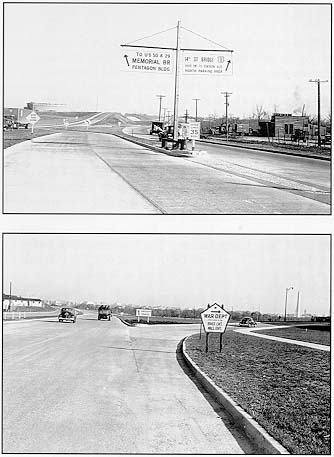November 28
| 1917 | Director Logan Page writes to the State highway commissioners seeking their help in reorganizing road work to meet normal needs plus relieve strain on railroads overburdened by military demands since the country entered World War I on April 6, 1917. He proposes a national road program, from which the highest priority projects would be advanced; coordination with railway and waterway facilities; coordination with the materials industry; and adjustment of State contracting procedures to meet needs. |
| 1943 | In a speech to HRB's 23rd Annual Meeting, Associate Highway Engineer D. W. Loutzenheiser of PRA discusses "Design of Signs for the Pentagon Road Network." He notes that over 400 signs were needed to direct and control traffic and emphasizes the problems and research involved in determining controls for the sign designs. |
| 1960 | Administrator Bert Tallamy, in his last annual address to AASHO, declares that, "In recent months critics and detractors have had a field day--viewing with alarm a few individual trees and losing sight of the forest. But I believe we are justified in sounding a few blasts on our own horns at this time." |
| 1967 | FHWA bans installation of rapidly fixed traffic sign supports and light poles in exposed areas of Federal-aid highways where breakaway or yielding supports can be used. |
| 1984 | In a letter to The St. Petersburg Times, Administrator Ray Barnhart responds to an editorial ("A Path of Death") that urged reconstruction of Alligator Alley (I-75) to include 40 tunnels for the endangered Florida panthers. Calling the editorial "a shallow and tricky treatment of environmental issues," Barnhart writes, "Well, as Colonel Potter in M*A*S*H used to say, 'Horsehockey!'" Subsequently, however, the Florida Department of Transportation was authorized to use Federal-aid funds to construct panther crossings along the route. |
| 1994 | Susan J. Binder, formerly Chief of the Industry and Economic Analysis Branch, Office of Policy Development, reports for duty as Maryland Division Administrator, the first woman to become an FHWA Division Administrator. |
| 1995 | President Bill Clinton signs the National Highway System Designation Act of 1995, which designates the NHS, but includes other provisions, including one repealing Federal involvement in setting speed limits. (See January 2, 1974.) Noting that the NHS unites major ports, airports, rail stations, and public transit, the President says, "The designation of the National Highway System makes clear that transportation infrastructure should be viewed as a single system with each mode complementing the others." |
| 1968 | Administrator Lowell Bridwell presents the First Annual Administrator's Award to 10 Headquarters employees: Deputy Director Edgar H. Swick; Chief Counsel Howard A. Heffron; Richard S. Salzman, Chief, Legislative Division; James E. Wilson, Deputy Director of Highway Safety Programs Services, NHSB; Daniel W. Fulmer, Director of Traffic Safety Secretariat, NHSB; Charles W. Prisk, Deputy Director for Safety; Kenneth L. Pierson, Special Assistant to the Director of BMCS; Joan B. Claybrook, Special Assistant to the Director, NHSB; Librarian Mildred W. Helvestine; and Director of Public Affairs Albert B. Kelley. |

